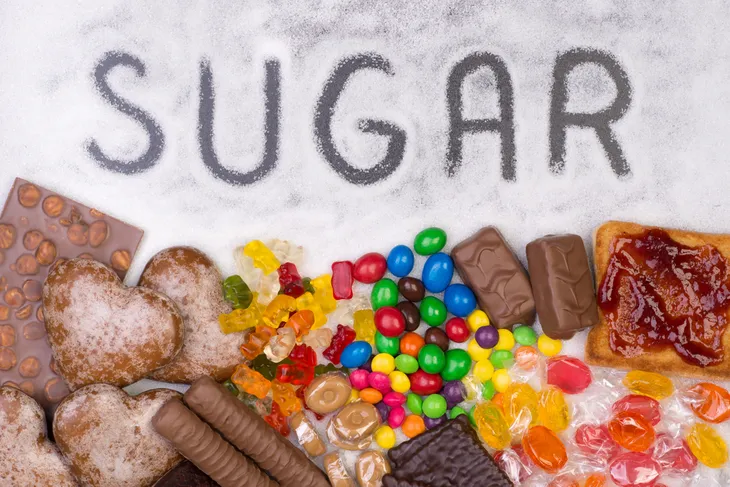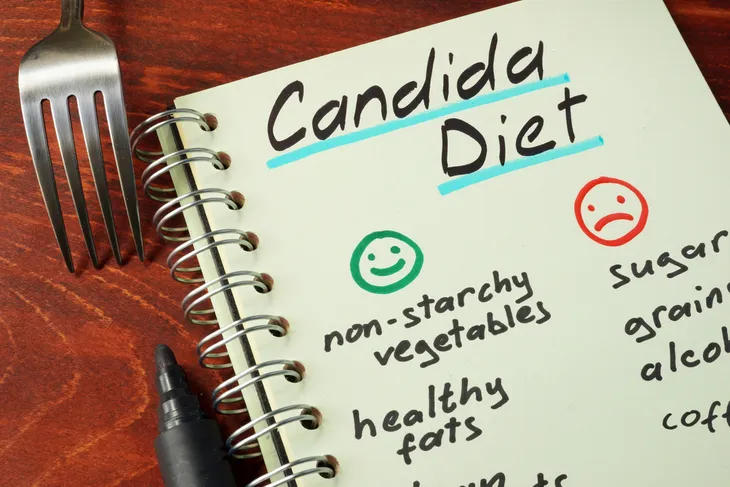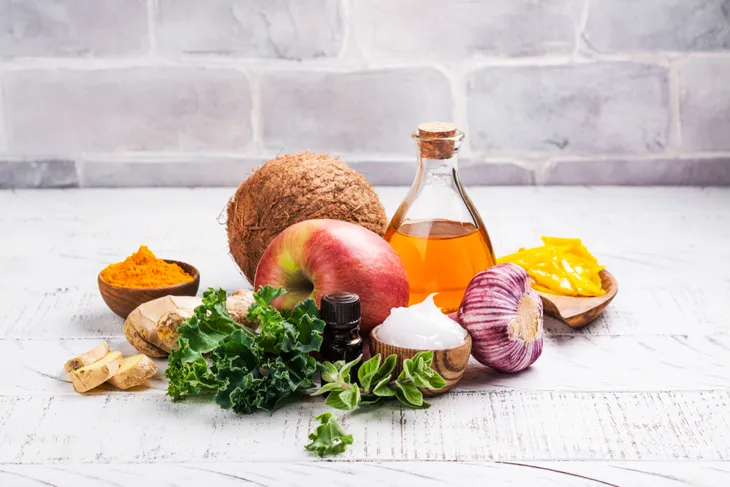Candida is a type of fungus that is commonly found in the human body. In fact, it’s found in many different areas, from the mouth and digestive tract to the skin and toenails, and more. While it’s usually harmless, if the fungus grows out of control, it can lead to an infection, resulting in a range of health problems. This is where the candida diet comes in. Some recommend the candida diet to help eliminate excess yeast in the body. It may also help restore balance in your gut. But is the candida cleanse diet actually safe, and is it worth trying?
What Is Candida and How Does It Affect Your Health?
In short, “candida is a yeast, which is a type of fungus,” explains WebMD. There are many different types of candida and over 150 species are currently living in many different parts of your body.
Candida isn’t all bad! Healthline points out “these species aid digestion and nutrient absorption from food.” But candida can become a problem if it grows uncontrollably or if it gets into your bloodstream or vital organs. In some cases, a serious infection known as candidiasis can develop.
Symptoms of an Infection
Even though 150 species of Candida are living in your body, only 15 can cause an infection, says Healthline. Of those 15 species, the source notes Candida albicans is the most common cause of infection. In fact, it accounts for over half of all cases.
So how do you know if you have an infection? One of the most common symptoms associated with an infection is fatigue but it may also cause anxiety or depression, and mood swings. Other possible symptoms include nausea, bloating, constipation or diarrhea, recurring urinary tract infections (UTIs), joint pain, and skin problems.
Risk Factors That Increase Your Chance of Infection
Certain factors can increase your risk of infection. For starters, eating sugar and refined carbs-rich diet as well as drinking a lot of alcohol can increase your risk. Having too much stress in your life can also play a role.
There are more risk factors, too. Taking birth control medication, antibiotics, or the improper use of catheters can also increase your risk. As can an imbalance in your microbiota, diabetes mellitus, or a weak immune system.
If you have one or a few of these risk factors, talk to your doctor about how you can make some changes. They may recommend dietary or lifestyle changes to help prevent your chance of infection.
What Is the Candida Cleanse Diet
The candida diet is a low-sugar, anti-inflammatory diet that aims to promote good gut health while also eliminating the sugars that feed candida overgrowth. The Candida Diet website says, “by improving your gut health, and restoring the balance of the bacteria and yeast that live inside your body, you can get relief from Candida symptoms like bloating, indigestion, yeast infections, fatigue, nausea, diarrhea, and gas.”
The diet consists of many healthy foods including non-starchy vegetables, gluten-free grains, as well as some low-sugar fruits, dairy products, and fermented foods.
How It’s Supposed to Work and Precautions You Should Take
As mentioned, the diet is supposed to work by eliminating sugars that feed candida overgrowth. Everyday Health points out, “one thing you may notice is that you may feel worse before you feel better: nausea, headaches, flu-like symptoms, and fatigue may appear within the first two weeks of the cleanse.” Rest assured, this won’t last for the entire duration of the diet. It’s also a sign that your body is “eradicating or removing something that was causing dysfunction,” says the source.
As with any cleanse or a strict diet, you should take some precautions. It’s important to talk to your doctor first to ensure it’s suitable for you to follow.
Getting Started: The Candida Cleanse
Ahead of starting the candida diet, Healthline says advocates recommend starting with a candida cleanse. It’s important to point out that a cleanse is not meant to be a long-term diet, but instead a short-term plan to help ” alleviate stress on your digestive tract and release toxins from your body,” says the source.
To do a cleanse you can try drinking only fluids such as soup broth (bone broth is a great option and is full of nutrients!) and water. But there are many other ways you can do a cleanse too such as eating mostly vegetables with small amounts of protein.
It’s also worth mentioning, there are currently no scientific studies to support the claims of a candida cleanse. That said, advocates believe it may help you get into the right mindset before starting the candida diet.
Possible Side Effects From the Cleanse
While the cleanse can help you prepare for the diet, there are some possible side effects worth mentioning. Possible side effects include headaches, fatigue, and mood swings. Changes in your sleep patterns are also possible.
As we mentioned, the cleanse is meant to be short-term, meaning it shouldn’t last for more than a couple to a days.
 9nong / Shutterstock
9nong / ShutterstockStarting the Candida Diet
Once you’ve completed the cleanse, you can start following the candida diet. Now you might be wondering how long you have to follow the diet. While there’s no definitive answer, some individuals claim they experience relief within a few weeks while others don’t see positive results for a few months.
To help you succeed, Healthline recommends starting slow. For example, instead of removing several foods, such as gluten, sugar, and caffeine, entirely from your diet, start by removing one thing at a time and gradually start to remove other foods as you go. The source also reminds us that this diet is meant to be short-term and only to be used until your symptoms have improved. The candida diet isn’t meant to replace your regular diet indefinitely.
It would also be a good idea to work with your doctor or dietician while following this diet to ensure you’re getting enough nutrients.
Foods to Eat on the Candida Diet
The good news is there are plenty of great foods to eat while following the candida diet. Here’s a list of foods you can start eating while following the diet:
- Non-starchy vegetables: artichokes, asparagus, broccoli, brussels sprouts, cabbage, cauliflower, celery, cucumber, eggplant, raw garlic, kale, onions, rutabaga, zucchini, spinach, and tomatoes.
- Low-Sugar fruits: lemon, lime, avocado, olives.
- Gluten-free grains: Oat bran, quinoa, millet, teff, and buckwheat.
- Protein: eggs, chicken, turkey, salmon, herring, wild sardines, and anchovies.
- Dairy: probiotic yogurt, butter, ghee, and kefir.
- Healthy fats: virgin coconut oil, flax oil, olive oil, and sesame oil.
- Low-mold seeds and nuts: sunflower seeds, flaxseeds, coconut, almonds, and hazelnuts.
- Spices, herbs, and condiments: black pepper, salt, cinnamon, clove, dill, garlic, ginger, oregano, rosemary, paprika, thyme, turmeric, basil, apple cider vinegar, and coconut aminos.
- Sugar-free sweeteners: xylitol, erythritol, and stevia.
- Fermented foods: olives, kefir, sauerkraut, and yogurt.
- Beverages: filtered water, chicory coffee, and herbal teas.
In addition to these foods, Healthline says, “probiotic supplements may help alleviate inflammation, kill off harmful organisms, and reduce the prevalence of candida and infection symptoms.”
Foods to Avoid on the Candida Diet
Although there is a long list of foods you can eat, there is also a generous list of foods you should avoid when following the candida diet. It’s worth noting, currently, there is no scientific proof that avoiding these foods will clear up a candida infection, however, this study suggests excessive sugar intake may make the infection worse. So with this in mind here are the foods you should avoid while following the diet:
- Sugars and artificial sweeteners: sugar, agave, aspartame, corn syrup, cane sugar, honey, maple syrup, and molasses.
- Grains that contain gluten: barley, wheat, rye, and spelt.
- High-sugar fruits: bananas, dates, raisins, mango, and grapes.
- Some meat and fish: processed meat, tuna, shellfish, and swordfish.
- Dairy: cheese, milk, and cream.
- Nuts and seeds high in mold: cashews, peanuts, pecans, and pistachios.
- Condiments: ketchup, barbecue sauce, horseradish, mayonnaise, white vinegar, and soy sauce.
- Refined oils and fats: margarine, canola oil, sunflower oil, and soybean oil.
- Beverages: caffeinated teas, coffee, energy drinks, fruit juices, diet and regular soda, beer, cider, liquor, spirits, and wine.
Potential Benefits
As with any diet, there can be potential pros and cons. For example, some other possible benefits from the candida diet include weight loss and reduced inflammation in the body.
It may also promote heart health and gut function. Since the diet heavily focuses on removing sugary foods, it may also help prevent obesity, diabetes, heart disease, and metabolic syndrome, says Healthline.
Potential Cons
One of the biggest cons of the candida diet is that there isn’t much human research to prove its effectiveness. And further, the available research is controversial, says Healthline.
Another possible con is that the diet can be restrictive. Removing sugar, gluten, starchy vegetables, some meats, fruits, and nuts, as well as alcohol and caffeine can be a real struggle for some individuals. It can also be difficult to follow if you’re on a tight grocery budget or don’t have time (or the motivation) to meal prep. On the plus side, this diet is not meant to be long-term, so you can find comfort in knowing you only need to follow it while you are experiencing symptoms of an infection.
Is It Safe and Is It Worth It?
Now that we have a better understanding of what the candida diet is, you might be wondering is it actually safe? Since the diet focuses on healthy low-sugar foods, high-quality produce, protein, and fats (that you should already be eating), yes the diet is safe.
The next question we need to address is, is it worth it? While there is no current strong evidence that supports the effectiveness of this diet, it is still a healthy diet you can follow. And may certainly be worth a shot to see if it works for you. That said, it’s always a good idea to talk to your doctor before making any drastic changes to your diet.
How to Prevent Candida Overgrowth
Along with the candida diet, there are other ways you can help prevent candida overgrowth. One of the best ways to prevent it is to always practice proper hygiene. This includes keeping your body clean and practicing good oral hygiene habits.
Following a healthy diet, in general, can also “help prevent complications and support your immune system,” says WebMD.
















